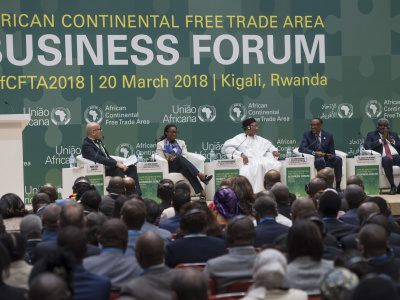
The AfCFTA: From institutional structures to private sector engagement
Despite a global pandemic and much scepticism about how you get 54 countries to bring a free trade area into being, the African Continental Free Trade Area (AfCFTA) is now underway. Or at least formally speaking – it can now be used by some companies, in some countries and for some products, while negotiations continue on outstanding issues.
And they’re off!
Some trade has reportedly taken place under the AfCFTA. Ethiopian Airlines, DHL and the African Electronic Trade Group are said to have partnered to ship the first goods under the agreement on 1 January 2021, taking goods produced in eSwatini to various countries that had signed and ratified the AfCFTA, including South Africa and Ethiopia. Other reports talk of two Ghanaian firms, a manufacturer of alcoholic products and a cosmetics company, that exported their products via air and sea freights under the AfCFTA in early January. These isolated cases, however, highlight the gaps between the political momentum around the AfCFTA and its technical application.
For the AfCFTA to have the intended impact, it will require businesses to know about it and be able to use it. That means improving the information available to the private sector, which goes beyond the high-level presentations seen in most webinars to include details on the agreed rules of origin and tariff offers relevant to their markets. There are opportunities for business associations and service providers with the technical expertise to develop tools for firms to understand better the implications and new market opportunities. International partners must also seek to support these efforts at the national, regional and continental levels.
An iterative process
The AfCFTA will not replace existing regional preferential trade arrangements, but link these with each other, and expand preferences to other countries where there are no arrangements currently in place. Existing agreements that will remain in place include the Southern African Customs Union (SACU) that covers trade between eSwatini and South Africa, Botswana, Lesotho and Namibia, as well as other agreements, including SADC for the wider Southern African region, ECOWAS, CEMAC, COMESA and EAC. If and when the Tripartite Free Trade Area comes into operation, it could potentially govern trade among SADC, EAC and COMESA countries that is not already covered by the AfCFTA.
The AfCFTA is creating a new agreement that will, in phases, cover trade between those countries that do not already have some other preferential arrangement in place, when both parties have ratified the AfCFTA and there is agreement on the tariff offers exchanged. It does not “consolidate fragmented markets but leaves a network of better connected and distinct trade regimes”, as one report puts it.
As such, particularly in the short run, the AfCFTA could increase complexity for traders, as the push for implementation has resulted in different tracks for various products and there are variations among the rules of existing arrangements and the AfCFTA.
Currently, trade under the AfCFTA is possible for 81% of tradable goods, as these already have agreed rules of origin in place. Negotiations are continuing on the rules for more sensitive products, including clothing and textiles, automotives and sugar. Some customs unions (such as CEMAC, EAC, ECOWAS and SACU) and individual countries (like the Democratic Republic of Congo, Egypt, Mauritius and São Tomé and Príncipe) have submitted tariff offers that cover at least those goods where there are rules of origin in place. South Africa has already gazetted the required documentation for implementation of trade under the AfCFTA, establishing the modalities that will need to be followed by traders to access the market access preferences.
At the same time, numerous international donors and other partners have been supporting negotiations and capacity building, and are designing programmes to continue to support AfCFTA negotiations and implementation. This has helped during a difficult phase of the negotiations, which had to move online due to the COVID-19 pandemic. Partnerships have also been critical in setting up the AfCFTA Secretariat in Ghana, with support from the likes of the African Development Bank (AfDB) but also the European Union (EU), the Deutsche Gesellschaft für Internationale Zusammenarbeit (GIZ), Denmark, France and Sweden. Support is also provided to regional organisations and African Union (AU) member states through the United Nations Economic Commission for Africa (UNECA) to establish national AfCFTA implementation strategies. There is no doubt that the AfCFTA is providing additional momentum for development contributions in a number of areas, including programmes related to infrastructure, industrialisation and capacity building.
This is all very well, and doubtless necessary to make the AfCFTA a success. But while institutional forms are important for AfCFTA trade to happen, what will be key is how they function.
That is, the effect of the AfCFTA will depend on the degree to which private sector companies across sectors and countries (1) are able to use the AfCFTA and (2) decide if it is worthwhile using it. That will necessitate a major effort across members to translate the agreement into practical processes and procedures, and assist companies to use them, where relevant, as reflected in Figure 1 for trade in goods.

Matching supply of agreements with demand to use them
In his analysis of different historical experiences of regional integration around the world, Walter Mattli points to the need for powerful forms of private sector or other ‘demand’ for greater regional integration to match the ‘political supply’ of the policies, institutions and organisational structures. That is, there must be non-state economic actors seeking gains through greater regional integration to match the supply from political leaders. This is also confirmed in case studies from the Maputo Development Corridor and integration in East Africa confirm, for example.
But to date there has been limited direct involvement of the private sector in the negotiations of the AfCFTA. It has largely been left up to individual countries to consult with national stakeholders through already established mechanisms that vary greatly in terms of effectiveness and inclusion. At the continental level, the African Business Council (AfBC) was launched in 2020, but it is still working on finalising its structures and membership before a first general assembly that is expected to be held later this year. The AfBC is expected to have a strong focus on supporting the implementation of the AfCFTA, but is not in a position to drive business engagement at this stage. Beyond questions on how effective regional business councils can be across such diverse economies, that leaves many traders and investors seeking more information about the AfCFTA agreement and how they can use it.
So the big question for the AfCFTA to actually have an impact is whether private sector companies are ready, able and willing to use it. And that seems likely to vary within and between ratifying states.
The core aim of the AfCFTA agreement on goods trade is to reduce tariffs on intra-African trade by an agreed percentage over an agreed period. Though initially focused on trade in goods, the agreement will be extended to trade in services and eventually also movement of people.
The timeframe for implementation of the tariff reductions will be agreed in line with the principle of reciprocity among negotiating parties, and may be applied retroactively to 1 January 2021. Making use of the preferences under the AfCFTA is not automatic however. Not only do the goods need to meet origin requirements, but this also has to be proven with supporting documentary evidence, while firms need to be pre-registered in terms of the agreement.
That is just the bureaucratic part. Before that, firms must be aware of the possible export opportunities but also the tariffs of potential export destinations under the AfCFTA, as well as the implications for competition from imports. There may not be any short-term gains or threats, but the AfCFTA will be with us going forward and have implications for strategic planning in the future.
The need for businesses to get informed and engaged is especially important as the negotiating process is still not complete. Once a company knows the tariff codes for the products it exports or imports, it can see if there will be changes to the import protection under the AfCFTA, and where there are going to be duties saved on exports to other African markets outside its existing regional free trade agreement. There are therefore opportunities in some member states, like South Africa, to review the offers that are now on the table and provide trade negotiators with direct and specific input on products of interest to their companies.
How this is done will vary by country, but in most cases it will be via business associations that can also assist with up-to-date technical information.
How to support this?
With implementation now moving strongly into focus, the action around the AfCFTA will become more regional and national. This provides an opportunity for partners who support the process to shift away from the continental level. Donors, regional economic communities and governments can now begin to seek bottom-up ways to support private sector engagement in the ongoing discussions within countries and regions, as well as in the design of the processes to encourage trade and investment.
Improving the information available to business would be a good start. This needs to go beyond the general level presentations to details on the agreed rules of origin and tariff offers relevant to their markets. Sending out large documents, often presented in a way that only makes sense to the negotiators, does not encourage private sector participation. There are opportunities for business associations and service providers with the technical expertise to develop accessible tools for firms to better understand the implications and new market opportunities.
Partners can also help to build capacity in government agencies that must now take what trade officials have negotiated and turn it into operating procedures that can be implemented at borders around the continent. The AfCFTA agreement itself provides guidance in this regard, but the steps for application in each country will differ and require specific consideration of national and regional circumstances.
The AfCFTA has been remarkable in terms of the commitment that has been shown by a diverse range of countries prepared to develop a complex set of trade rules. It has provided a chance for African countries to test and hone their capacity in trade negotiations. Now is the time to bring on board more actively the private sector and supporting government players, like customs administrations, who are key to ensuring that the world’s largest trade agreement lives up to its full potential in the future. Without this, the AfCFTA risks creating an empty framework, or one where only a few manage to take advantage of it – and that is not the ‘Africa we want’.
Catherine Makokera Grant is a Director at the Tutwa Consulting Group and participates in NEDLAC discussions on the AfCFTA on behalf of Business Unity South Africa.
The views are those of the authors and not necessarily those of ECDPM, Tutwa Consulting Group or Business Unity South Africa.




